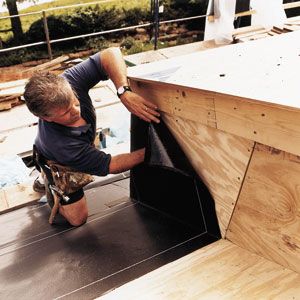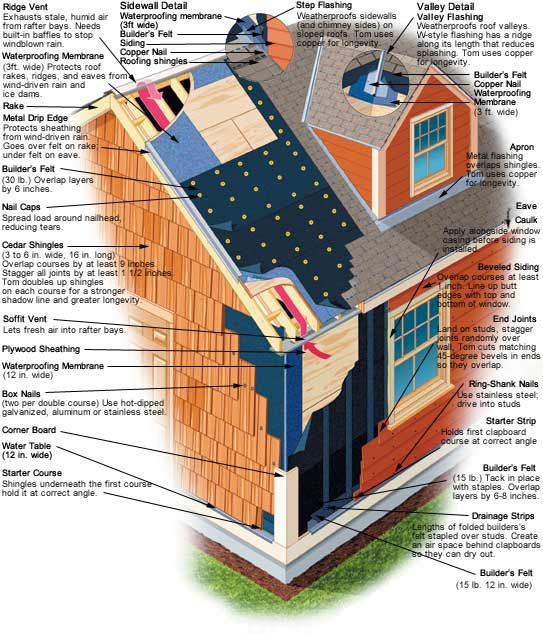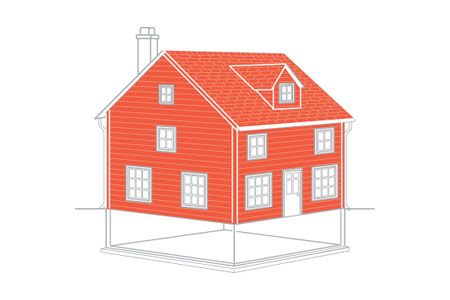There’s more to choosing your home’s roofing and siding than appearance. These features are also your home’s first line of defense against weather, so it’s important that they’re durable, properly installed, and well-maintained. Traditional options such as wood and brick are time-tested but pricey. Now, we have synthetic look-alikes that cost less and don’t require as much upkeep.
“You used to have to choose between low-maintenance and nice-looking,” says Tom Silva, This Old House general contractor. “Today, you can have both.” This guide will walk you through everything you need to know about roofing and siding, from material selection to installation and maintenance.
Traditional Roofing Options
Traditional roofing materials have been used for centuries and are known for their timeless style and durability. Some popular options include the following:
- Wood: Cedar shakes and shingles for roofing, clapboard for siding
- Slate: Natural stone tiles for roofing
- Clay tiles: For roofing, especially in Mediterranean-style homes
- Brick and stone: For siding, offers a classic and sturdy appearance
While these materials are beautiful and long-lasting, they’re often expensive and may need more maintenance.
Modern Roofing Alternatives
In recent decades, manufacturers have developed new materials that look similar to traditional options while offering improved wear resistance and fewer maintenance needs. Some modern alternatives are asphalt shingles, which are cost-effective, and metal roofing, which is durable and energy-efficient.
These modern options often have a good balance between design, performance, and cost.
Eco-Friendly Roofing Options
As homeowners become more environmentally conscious in their buying decisions, the roofing and siding industry has developed eco-friendly and energy-efficient alternatives, such as these:
- Metal roofing: Often made from recycled materials and is fully recyclable
- Cool roofs: Reflects more sunlight and absorb less heat, reduces energy costs
- Green roofs: Covered with vegetation, provides insulation and reduces stormwater runoff
Selecting the Best Siding
When choosing siding, consider durability, maintenance, energy efficiency, and style. Popular siding options include the following:
- Vinyl siding: It’s low-maintenance, affordable, and available in many styles and colors. Vinyl siding can also be installed with an additional layer of insulation for increased energy efficiency.
- Fiber cement siding: Fiber cement is a durable, versatile material that can mimic wood or stucco. This material offers good insulation and weather resistance.
- Wood siding: Wood siding is a traditional choice with a natural finish.
- Engineered wood siding: Engineered wood siding combines the look of wood with improved strength. This type of tile siding is made from sustainable materials and provides quality insulation.
Preparing Your Home for Roofing or Siding Installation
One of the most important steps in preparing your home for new roofing or siding is waterproofing. Silva recommends using waterproofing membrane, a self-adhesive, peel-and-stick material that seals itself around fasteners to form a moisture barrier.
While the membrane is highly effective, it’s sensitive to sunlight and must always be covered with siding, roofing, or metal flashing. After applying the waterproofing membrane to vulnerable areas, the next step is to cover the entire surface with builder’s felt. This paper is thick and made with asphalt, providing additional protection against moisture.
Silva prefers using traditional materials such as builder’s felt or rosin paper over modern plastic housewrap, especially when insulating with spray foam. “There’s no air or moisture passage to worry about,” he explains. Whether over felt, paper, or a wrap, he tacks up drainage strips before he hangs wood siding. “It needs an air space behind so it can dry out.”

Step-by-Step Roofing Installation
The details of installing a roof vary depending on the material, but these are the general steps:
- Remove your old roofing materials.
- Inspect and repair the roof deck.
- Install an ice and water shield along the eaves.
- Apply roofing felt over the entire roof.
- Install a drip edge along the roof perimeter.
- Begin laying roofing material from the bottom up.
- Install flashing around chimneys, vents, and other protrusions.
- Complete the ridge cap installation.
We recommend hiring professional roofers for proper installation and warranty coverage. Attempting a roofing project yourself can be dangerous and lead to costly damage to your home if not done correctly.

Step-by-Step Siding Installation
Installing siding is slightly more DIY-friendly, but it still takes precision and skill. We recommend hiring a professional contractor for the best results, but here’s a look at the process:
- Make sure the wall surface is clean, dry, and prepped.
- Install a weather-resistant barrier (housewrap or builder’s felt).
- Apply flashing around windows, doors, and other openings.
- Install starter strips at the bottom of the walls.
- Begin installing siding panels from the bottom up.
- Use proper nailing techniques to allow for expansion and contraction.
- Install trim around windows, doors, and corners.
Roof Maintenance
Regular roof maintenance can prevent minor issues from becoming major problems. Here are some tips:
- Inspect your roof biannually and after severe weather events.
- Clean gutters and downspouts regularly.
- Trim overhanging tree branches.
- Replace damaged or missing shingles immediately.
- Check for signs of water damage in your attic.
Siding Maintenance
Different siding materials have different maintenance needs, but you can follow these general tips:
- Clean siding annually with a soft brush and mild detergent.
- Inspect for damage, loose panels, or signs of pest infestation.
- Touch up paint or stain as needed.
- Keep shrubs and plants trimmed back.
- Address any moisture issues promptly to prevent rot or mold.
Roofing and Siding Cost Considerations
The cost of roofing and siding projects can vary widely based on materials, labor, and project scope.
Roofing Costs
Roofing costs depend on factors such as material choice, roof size, and complexity. Here are the averages for common materials:
- Asphalt shingles: $1– $3 per square foot*
- Metal roofing: $3– $29 per square foot
- Slate: $8–$18 per square foot
Remember to factor in additional costs for underlayment, flashing, and labor.
*Cost data in this article is based on contractor estimates used by Angi.
Siding Costs
Siding costs also vary based on material and installation complexity. Below are typical price ranges:
- Vinyl siding: $3–$12 per square foot
- Fiber cement siding: $5–$14 per square foot
- Wood siding: $1–$15 per square foot
Additional costs may include insulation, trim work, and removal of existing siding.
Innovative Products in Roofing and Siding
The roofing and siding industry continues to grow with new products that offer improved performance and energy efficiency.
Solar-Powered Roofing
Solar roofing technology has advanced significantly in recent years. Power-generating roof shingles can now considerably reduce a home’s electrical demand. These products are available in “slates” that produce 920 watts per 100 square feet or flexible shingles generating 600 watts per 100 square feet.
While the initial cost is higher than traditional roofing materials, the long-term energy savings can be major. Homeowners can enjoy watching their electricity bills decrease over time.
Advanced Siding Technologies
Innovations in siding technology have addressed common issues with traditional materials. For example, solid-core vinyl siding has a foam backing that provides a stiffer, more impact-resistant panel. This technology allows for wider exposures and improved insulation and eliminates the hollow, concave look often found with standard vinyl siding.
Another noteworthy new material is fiber-cement siding, which offers the look of painted wood without the risk of rot, and it’s warranted for 50 years.

